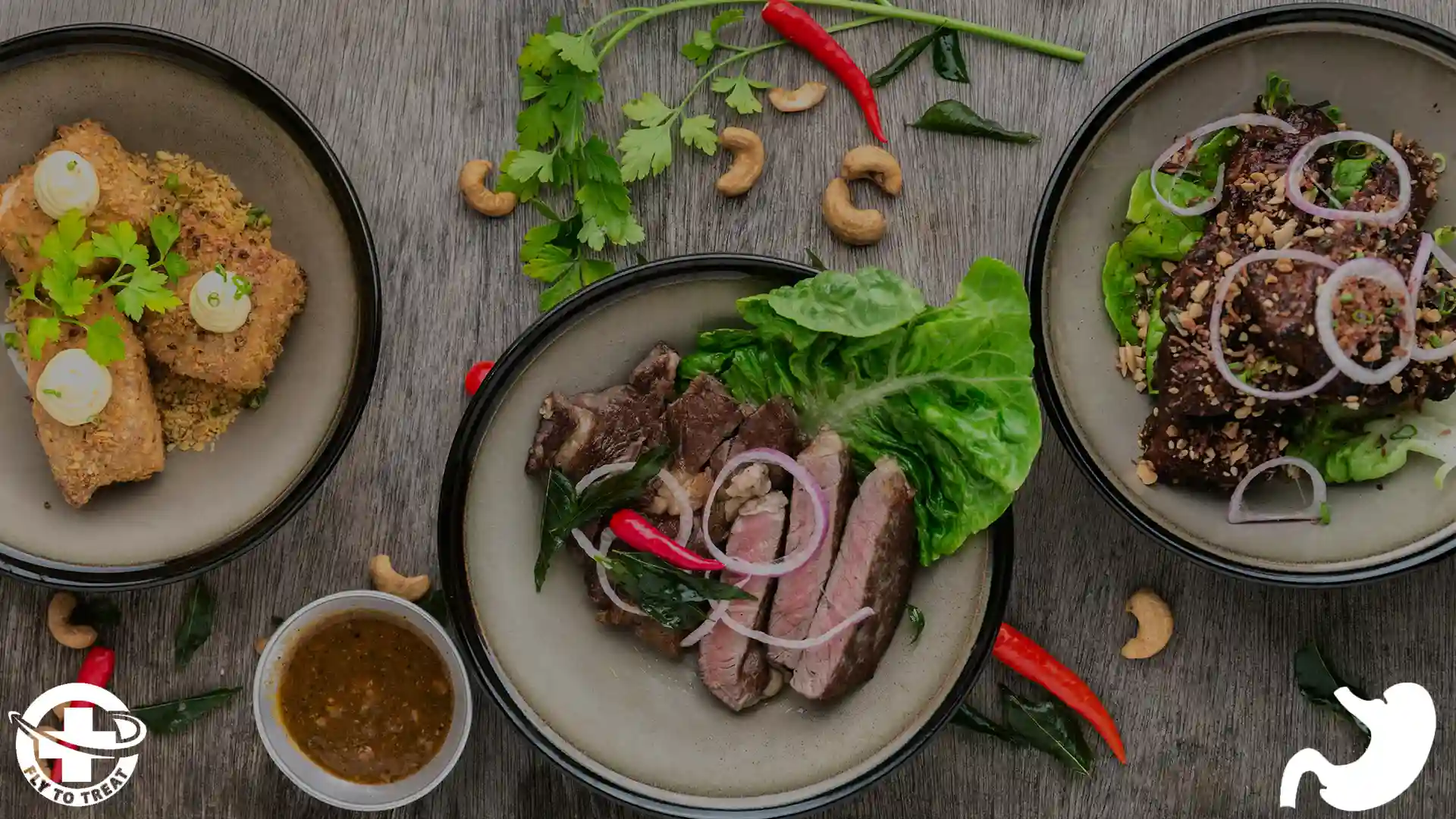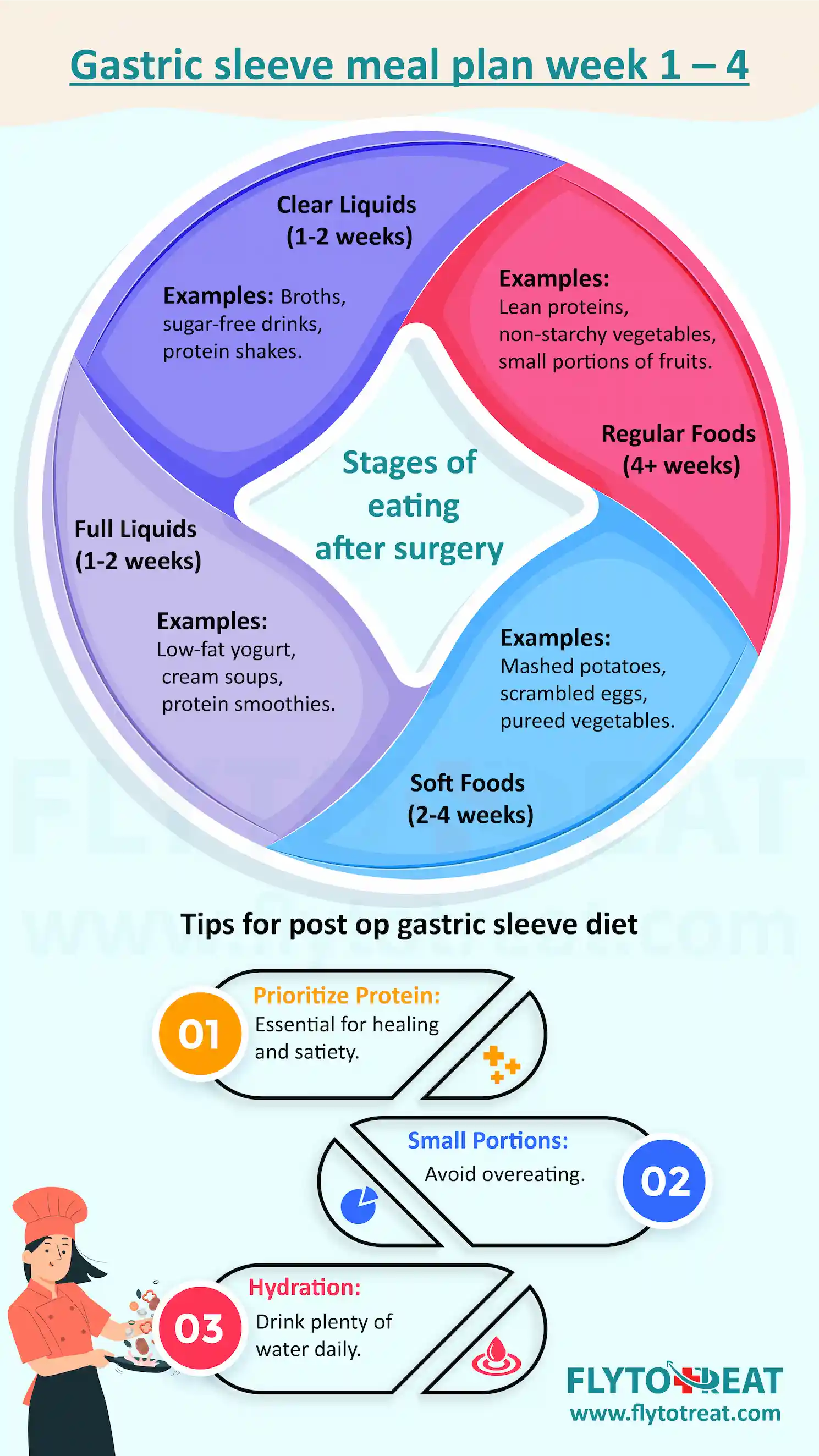
What is the menu after bariatric surgery?
Starting your gastric sleeve meal plan is key to your recovery and long-term health after surgery. In this comprehensive guide for post bariatric meal plans, we focus on guiding you through each stage with a nutritious and satisfying plan. This plan includes clear liquids to full meals, prioritizing lean proteins, vegetables, and fruits to ensure you get the nutrients you need in smaller portions in your eating plan after gastric sleeve. It's about making healthy eating a part of your life with FlyToTreat's support every step of the way.
What is the menu after bariatric surgery?
The gastric sleeve meal plan is a structured approach to guide you through the different stages of eating after surgery. Here's a breakdown of what to expect when it comes to bariatric sleeve meals:
• Stage-by-Stage Progression: The plan progresses from clear liquids to full meals over several weeks or months.
• Focus on Nutrients: Each stage emphasizes nutrient-rich foods like lean protein, vegetables, and fruits to ensure proper nutrition despite smaller portions.
• Guidance, Not Restriction: It serves as a guide, not a strict restriction. You'll work with your doctor or dietitian to personalize the plan based on your needs and progress.
Although various resources are available online on bariatric sleeve meals, consulting a healthcare professional in your gastric sleeve team is crucial for a tailored approach to your successful eating plan after gastric sleeve surgery.
Gastric sleeve menu plan
The gastric sleeve meal plan is a personalized journey, but here's a general roadmap for the different stages:
Stage 1: Clear Liquids (1-2 weeks)
• Focus on clear broths, sugar-free water-based drinks, and unsweetened protein shakes for your post op gastric sleeve meal plan to stay hydrated and support healing.
Stage 2: Full Liquids (1-2 weeks)
• Introduce thin, creamy liquids like low-fat yoghurt, cream soups, and protein smoothies. Aim for protein in each meal.
Stage 3: Soft Foods (2-4 weeks)
• Progress to mashed potatoes, scrambled eggs, well-cooked, flaked fish, and pureed vegetables. Remember, small portions and prioritize protein.
Stage 4: Regular Foods (4+ weeks)
• Reintroduce solid foods gradually, prioritizing lean protein sources with non-starchy vegetables and small portions of fruits.
This is a general guideline. Surgery teams will create a menu for gastric sleeve patients tailored to their needs and recovery timeline. They can also recommend specific resources like bariatric sleeve meal plans to help you pass the recovery road.

Full liquid diet menu gastric sleeve
The gastric sleeve meal plan progresses to full liquids in Stage 3, typically lasting 1-2 weeks. Here's a sample menu to guide you:
• Breakfast: Opt for a protein smoothie with low-fat milk, unsweetened protein powder, and a hint of fruit for a satisfying start.
• Lunch: Enjoy the cream of vegetable soup with a swirl of low-fat yoghurt for added protein and creaminess.
• Dinner: Blend cooked chicken or fish with low-fat broth and a sprinkle of herbs for a flavorful, protein-rich meal.
• Snacks: Choose sugar-free yoghurt with mashed berries or a protein pudding made with low-fat milk and protein powder.
Remember:
• Thin is In: To prevent discomfort, all liquids should be thin and easily consumed.
• Protein Powerhouse: Prioritize protein in each meal to keep you feeling full and support healing.
• Hydration matters: Continue to drink plenty of water throughout the day to stay hydrated.
Bariatric pureed meals
Bariatric pureed meals are a crucial part of the gastric sleeve meal plan during Stage 2, typically lasting 1-2 weeks after surgery. Here's a sample to help you overcome this phase:
• Breakfast: Blend cottage cheese with fruit (avoid added sugars) for protein and sweetness.
• Lunch: Pureed cooked chicken or fish with a splash of low-fat broth for protein and hydration.
• Dinner: Blend steamed vegetables like carrots or broccoli with lean protein like tofu or lentils for a complete meal.
• Snacks: Opt for protein smoothies made with unsweetened protein powder, low-fat milk, and a touch of fruit.
Remember:
• Consistency is Key: All food should be smooth and lump-free for easy digestion.
• Protein First: Prioritize protein in each meal to promote healing and satiety.
• Hydration Matters: Drink plenty of water throughout the day to prevent dehydration.
Your doctor or dietitian will create a personalized gastric sleeve menu plan based on your needs and preferences. They can also provide detailed recipes and resources for bariatric pureed meals.
Healthy meals after gastric sleeve
The gastric sleeve meal plan transitions to a focus on healthy eating habits for long-term success. Here's a sneak peek at what your plate might look like:
• Breakfast: Scrambled eggs with chopped vegetables and a slice of whole-wheat toast provide protein, fibre, and complex carbohydrates for sustained energy.
• Lunch: Grilled chicken breast with a side salad featuring leafy greens, a drizzle of olive oil, and a sprinkle of nuts offers protein, vitamins, and healthy fats.
• Dinner: Baked salmon with roasted vegetables like broccoli and sweet potato delivers essential protein and various nutrients.
• Snacks: A handful of almonds or Greek yoghurt with berries provides protein and healthy fats for satiety between meals.
Remember:
• Protein Priority: Focus on protein at every meal to feel fuller for longer and support muscle health.
• Portion Patrol: Stick to small, controlled portions to avoid overeating and discomfort.
• Nutrient Diversity: Choose a variety of colourful fruits, vegetables, and whole grains for a balanced intake of vitamins, minerals, and fibre. Click for more information about vitamins after gastric sleeve,
VSG Keto meal plan
The ketogenic diet (keto) and gastric sleeve surgery (VSG) are both effective weight loss strategies, but combining them can be complex. Here's what to consider:
• Postop Restrictions: Early postop gastric sleeve meal plans prioritize protein and small portions, which may not align perfectly with a high-fat keto approach.
• Nutrient Needs: Keto restricts carbohydrates, potentially limiting essential vitamins and minerals. This can be a concern after VSG surgery.
• Doctor's Guidance: Consulting a healthcare professional is crucial before attempting a VSG keto meal plan. They can assess your individual needs and create a safe, balanced approach.
Remember:
While some have found success with a VSG keto plan, it requires careful monitoring and medical supervision. It may only be suitable for some. Focus on prioritizing protein and healthy eating habits for optimal results after gastric sleeve surgery.
Gastric sleeve meal ideas
Following a gastric sleeve meal plan doesn't have to be bland! Here are some inspiring ideas to keep your meals for gastric sleeve exciting:
• Breakfast Scramble: Whip scrambled eggs with chopped vegetables and lean protein like turkey sausage for a protein-packed start.
• Souper Lunch: Pureed soups made with roasted vegetables and a touch of cream offer a comforting and nutritious option during the early stages.
• Mini-Taco Fiesta: Load mini whole-wheat tortillas with seasoned ground turkey, a dollop of Greek yoghurt, and chopped veggies for a fun and flavorful twist.
• Snack Attack: Snack on protein-rich options like Greek yoghurt with berries, a handful of almonds, or sugar-free protein pudding.
• Sheet Pan Simplicity: Throw lean protein like salmon or chicken with colourful roasted vegetables for a fuss-free and healthy dinner.
These are just a few ideas to get your meals for gastric sleeve started. Explore post bariatric meal plans online or consult a dietitian for personalized meal plans tailored to your preferences and stage in your post-surgical path.

Conclusion
Following a gastric sleeve meal plan is crucial for your recovery and long-term success. FlyToTreat helps simplify this journey and is more effective by offering guidance on what to eat from the initial clear liquid stage to enjoying full, balanced meals. Remember, the postoppostop gastric sleeve meal plan is about finding a new, healthier way to enjoy food while sticking to your goals. With FlyToTreat, you're not alone in making these important changes to your diet and lifestyle.

MEDICALLY REVIEWED BY: Dr. Ali Bazazi
AUTHOR: FlytoTreat's team of Authors
26 March 2024 - Updated At: 21 July 2024
Related Articles
Comment




